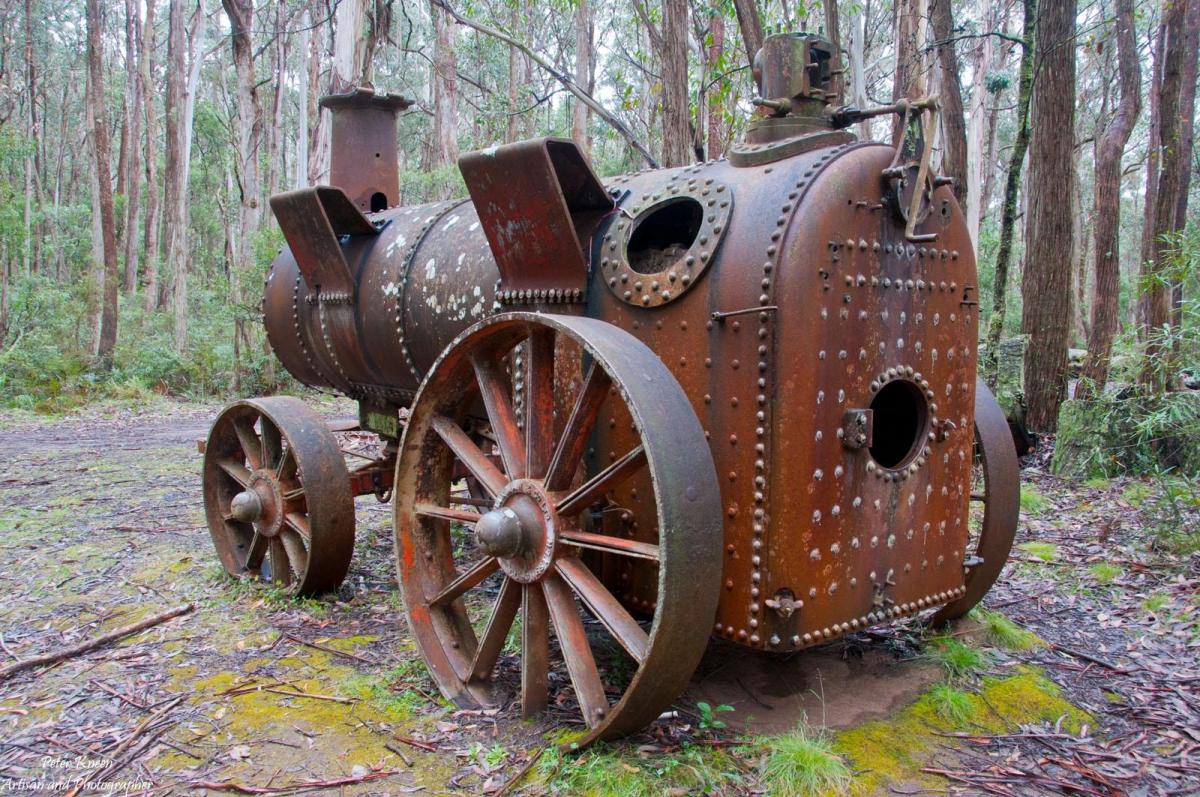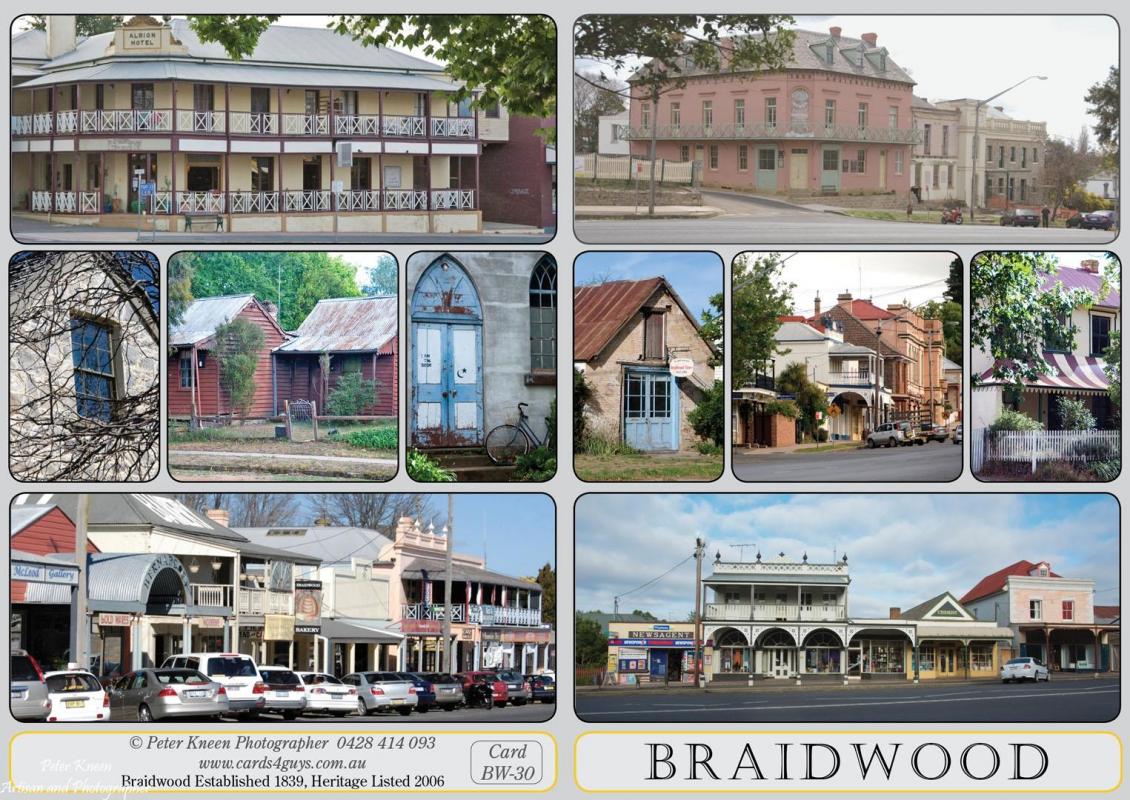I have produced a number of blank greeting cards depicting heritage structures, machinery, transport or "the bush"
Minimum order of 20 (at $2.00 each) and postage and handling within Australia only ($5 for 20, free for 40 or more)
Normal retail price in shops has been $AUD 4.00
There is a short description of the image on the back of each card. Wrapped in cello with a plain white envelope.

Steam locomotives 5595 (2-8-0) constructed by Clyde Eng. in 1912 is a hybrid design of American and British engines. It was in use until the 1960s and is the sole remaining D-55 class. The 5910 (2-8-2) was built in 1952 by Baldwin. It is a heavier and longer engine which caused some trouble fitting on turntables. Trainworks Thirlmere

The branch railway line from Cootamundra to Tumut closed in 1984 almost 100 years after being constructed. The station then fell into disrepair. During the 1990s, an old cast iron water tank was found and the timber supporting structure was built in the original style.

This Garratt steam engine 6040 (4-8-4 + 4-8-4) was the last steam loco to enter service in 1957 before diesel engines took over. The massive tractive effort of these engines was important for goods trains in NSW. Withdrawn in 1967.

Built in 1901 for Australia’s first Governor General, Lord Hopetoun using exceptional materials and workmanship, it features hand carved cedar panels, silk drapes, gold-plated fittings, etched glass panels and elaborate Victorian fittings. Used by Queen Elizabeth II in her 1954 visit to Australia. Train Works Thirlmere.

OK to turn now - the best backseat driver I've ever had!

This approaching storm was to bring more than 40mm of rain to a normally dry part of the continent. Central Australia has experienced several consecutive years of well above average rainfall leading to Lake Eyre being filled for the first time in recent history. In this picture we see wildflowers are in bloom after previous rain. They extended for hundreds of kilometres through the desert. After this storm, many tracks and roads were impassable for days and weeks. Note the small spider at the bottom of the image.

Cope Hut was built as a refuge ski hut in about 1929 by the Ski Club of Victoria. The hut has a rough adzed timber frame and now polished hardwood floor with a corrugated iron roof. Materials came via Dibbins Hut by dray then by sled to the High Plains. The hut was classified by the National Trust in 1988. There is an efficient slow combustion stove and solid bunks for up to 16 persons. A separate firewood room makes this one of the warmest huts during winter. Some magnificent stands of snow gums have escaped recent bushfires.

Delightful, shy beautiful animals with captivating eyes. Alpacas originated from Peru and the modern Australian industry started in the late 1980s. Today there would be about 100,000 animals being bred and used for their very fine fleece. There is an extensive range of associations, shows and outlets selling alpaca goods.

Tasmania has some remote and beautiful lakes. A perfect setting to get totally away from the worries of the world. Southern end of Lake Burbury, east of Queenstown

This 5 tonne lifting capacity jib crane comprises sufficient gears to enable man power to be able to lift wool bales, timber and other freight to and from goods trains. The goods station is about 2-300 metres from the passenger station at Gundagai. A significant goods shed has been maintained on the siding tracks.

Located in a timber logging camp at Lowden Park west of Braidwood, NSW this stationary steam engine provided power to a saw mill. Today a number of relics including a water wheel makes for a delightful picnic and small camping area.

Marree sprung up in the 1880s and was a major station on the overland telegraph line as well as the original Ghan Railway line. This is one of the preserved relics in the centre of town. Marree is at the southern end of the famous Birdsville Track. Also is the old Kruze Mail Truck.

A collection of traditional wooden clinker built rowing boats outside the Wooden Boat Centre on the Huon River at Franklin, Tasmania

Two fishermen returning after an early morning fish produced this perfect wake in the shadows of the mountains surrounding a reservoir. Lord Kelvin (1824-1907) first described the wave patterns in a wake. Wavelets spread out at approx 19 degrees and the waves at 53 degrees to the direction taken by the boat.

Classic vintage cars are a passion for many as this exquisite dashboard from a 1920s Rolls Royce shows.

Rodeos are a way of life throughout rural Australia with many participants moving from one rodeo town to another. Some custom made saddles stand out in the crowd. Braidwood NSW

Alex Guy built the hut in the late 1930s for mustering on the Snowy Plains. He acquired the use of these plains and the Wonnangatta Station in 1934. The original hut was extended in height to seven logs. The roof and chimney are clad now with corrugated iron. The internal fireplace is of a very generous size.

Located in the old Gundagai Railway Station, now preserved as a museum by local enthusiasts, these are a variety of oil and kerosene lamps used by station and train staff. Now home to a few spiders

An interesting farm or shearing shed outside Omeo, Victoria

The railway line was extended from Gundagai in 1903 and required the construction of a long bridge across the extensive flood plains of the Murrumbidgee River. The timber truss viaduct bridge is the longest timber bridge structure in Australia and remained the longest bridge until the opening of the Sydney Harbour Bridge in 1932. A 61m long steel truss bridge spans the main river. The line closed in 1984.





































